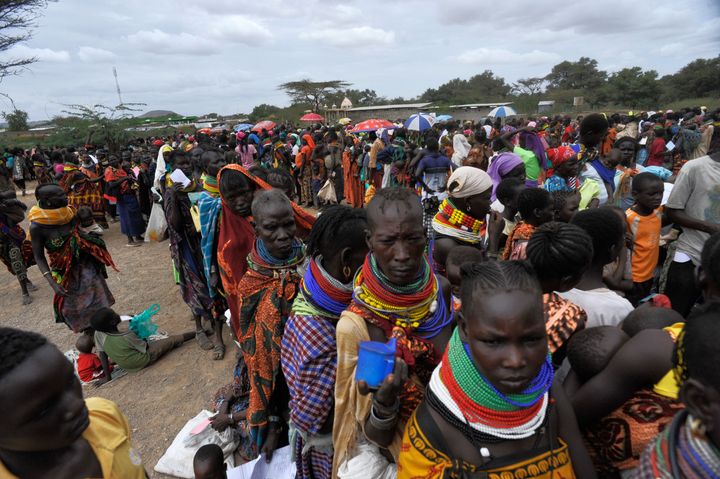
Due to the drought devastating parts of rural Kenya, the marginalized, chronically poor populations in Nairobi's slums are now facing a large-scale, life-threatening emergency as the price of basic staple foods has doubled.
For the first time in history, more than half of the world's six billion people live in towns and cities. By 2030, the urban population is expected to rise to almost 5 billion people, concentrated mostly in Africa and Asia.
Today, approximately one in every six people worldwide live in poverty in urban slums. Living conditions are overcrowded, dangerous, and unsanitary, and residents lack access to adequate shelter, clean water, health care, waste collection, or education. But unlike rural communities living in extreme poverty, the needs of the urban poor are often underserved and overlooked when shocks endanger their survival.
In Kenya's capital city of Nairobi, two-thirds of the population live far below the poverty line in sprawling urban slums. Hunger is an everyday reality here: most people live on the edge, spending between 40 to 60 percent of their average $1.50 a day household income on food. With the remaining portion, they have to pay for water, use of latrines, rent, and school fees.
Today, the worst drought in 60 years―combined with dramatic spikes in food prices―has triggered a catastrophic food crisis, leaving 3.5 million Kenyans in need of immediate food assistance. Rural, pastoralist communities in the north have been devastated, with massive deaths of livestock and alarming rates of malnutrition making headlines around the world.
The marginalized, chronically poor populations in Nairobi's slums are also facing a large-scale, life-threatening emergency. Over the past 5 months, the price of basic staple foods has doubled, and there is less food available in the markets. The urban poor have been forced to buy less and eat fewer meals, and families are resorting to desperate measures to get by. Food is quickly becoming an unaffordable luxury. Children are suffering most: in nutrition centers supported by Concern in the slums, there has been a 62 percent increase in admissions for treatment of severely malnourished children.
But because the urban poor are always close to the brink, it is hard to document when they spiral into an actual emergency. Because international emergency indicators were not developed for use in urban contexts, there is no benchmark that signals the need for a major humanitarian intervention. Today, despite all the alarming warning signs in plain view, the situation in the slums remains largely "invisible."
Dominic Meteka lives in Korogocho slum. He earns about 170 shillings a day sewing small containers made of old flour and rice sacks. He has three children and a wife, and can't afford to feed them anymore. From the 170 shillings he earned today, he had to pay 100 to his landlord because he is three months behind on his rent. With the remaining 70 shillings, he can only buy ¾ of a kilogram of maize flour. Before the drought and the spikes in food prices, he and his family used to eat three times a day. Now, they only have tea in the morning, and one small bowl of cornmeal porridge or rice in the evening.
Dominic says that this has been going on for a few months. At first, his children would come to him asking for more food, especially his five-year-old son. "They would look in the house for food, and they would cry when they could not find it," Dominic remembers. "But now they are used to it. When we eat, there isn't enough to get full. I tell my children to persevere, and that there will be another meal tomorrow."
He knows the drought is bad in the north, but he says no one is paying attention to the suffering that the drought has brought to the slums. The reports on the radio and in the papers are all asking people to help and to send aid to the north. "But we need food here in the slums. I saw children on the street who fainted because they hadn't eaten in five days. I know people here will die, too, if we don't get help."
Dominic says this food crisis is the worst he has ever seen: "When there is rain, there is food. But there has been no rain. And there is no food." Some men in the slums are running away, abandoning their families. "Their children are hungry and crying, and they cannot do anything to feed them. So the men are running away."
Until now, Dominic has been able to support himself and his family. He used to have three sewing machines for his small business. He sold two of them to pay his children's school fees. "I am trying my level best to keep my children in school so they do not have problems like mine. We are all very hard-working people. If the people here can get support, I know we can uplift ourselves from this crisis," he says.
Concern Worldwide has launched an emergency livelihoods program and an emergency nutrition program to reach 20,000 of the most vulnerable people in the slums of Korogocho and Viwandani in Nairobi. Our nutrition program will support the Ministry of Health to screen and treat children under five for malnutrition. Our livelihood program will provide the most vulnerable families with monthly instalments of emergency cash through mobile phone technology, providing immediate resources to meet their basic survival needs. Concern is also doing research to develop and share emergency indicators for urban crises.